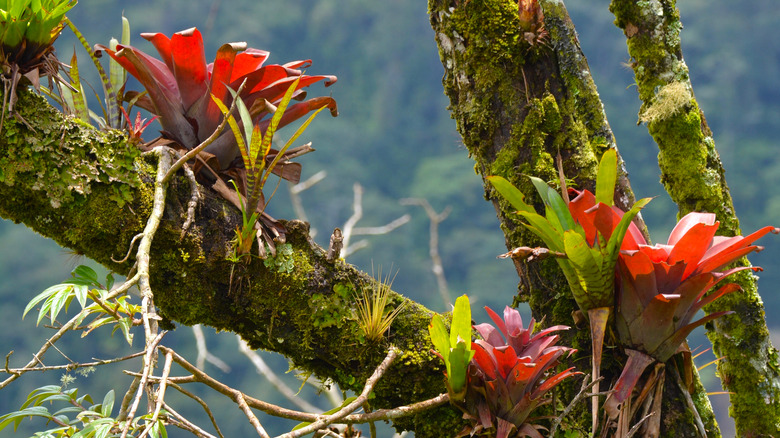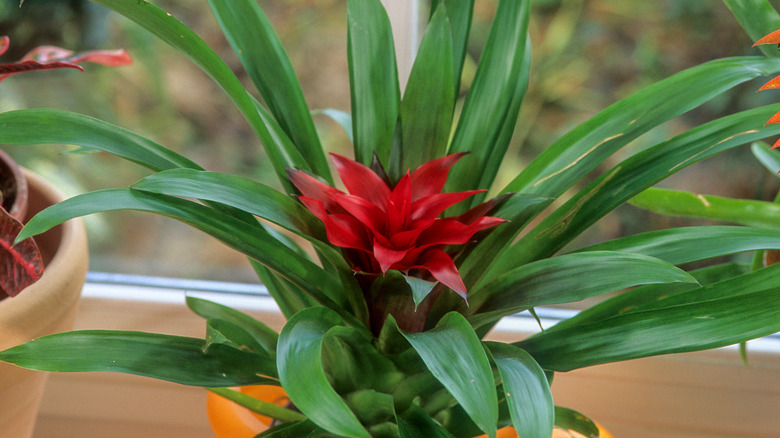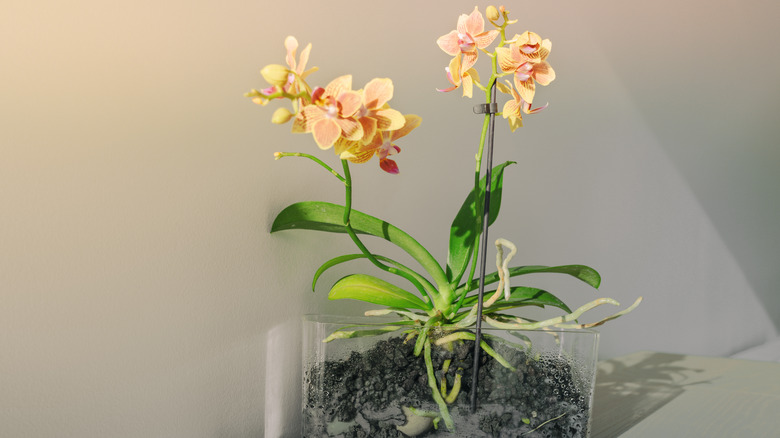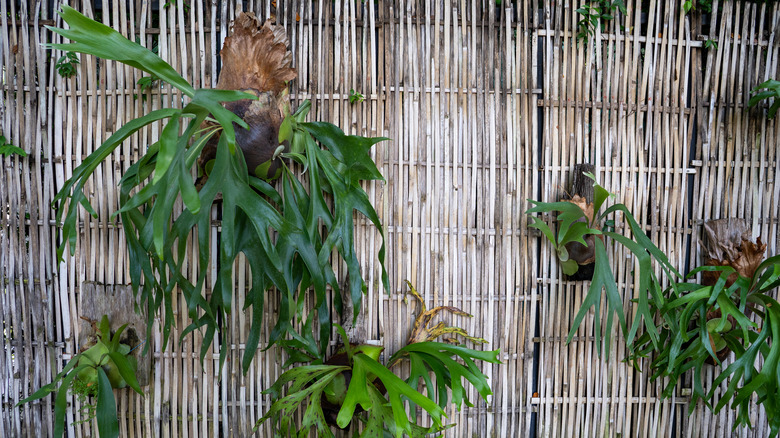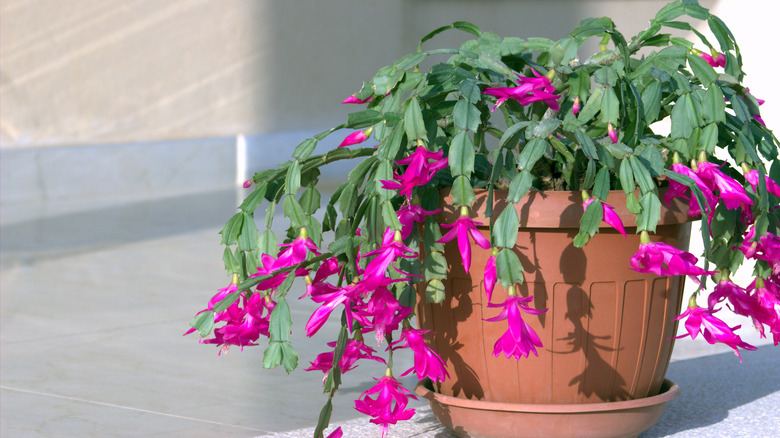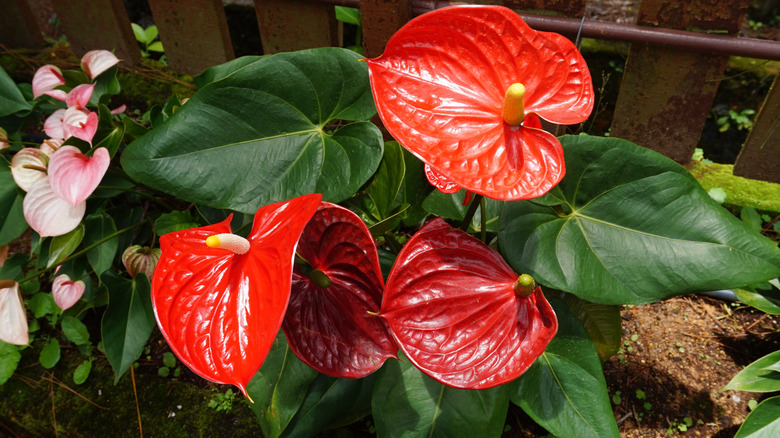5 Types Of Epiphytes That Make Great Houseplants
Epiphytic is a Greek word that translates roughly to "upon plants." Therefore, epiphytes are plants that can grow by sitting on tree trunks or hanging from rock walls without sending roots down into the ground. Instead of relying on nutrient-rich soil for food and water, they instead receive everything they need from the air and rain that falls around them. As such, Gardening Know How explains that they should not be thought of as parasites because they do not derive nutrients from a host plant, they simply live on top of it.
In nature, epiphytes, sometimes called air plants, grow on trees. But that should not discourage you as a houseplant enthusiast who likely does not have a tree growing through their living room — and if you do, we are way jealous. Given the right environmental conditions, epiphytic plants can be quite happy in the home, and they add a touch of the unusual to any décor.
There are some general rules to follow to keep air plants healthy. Never overwater or place them in direct sunlight. In their natural environments (think tropical jungles) they receive only filtered light through thick tree canopies. And most importantly, grow them in areas that you will be able to keep warm and humid throughout the entire year. Though they are not succulents, many epiphytes require very little extra watering. Humid conditions and gentle misting are often enough.
Bromeliads
The bromeliad family (Bromeliaceae) is not the kind of brood you're going to invite over for dinner, simply because there are over 3,000 of them. Even if you had room for them all, how on Earth would you manage to feed them? Among relatives within the family, you'll find everything from pineapples to Spanish moss to those bright tropical flowers with showy green foliage, like the Scarlet Star (Guzmania lingulata) shown in the picture above.
Some bromeliads are terrestrial, meaning they require soil to grow. But many of them are epiphytic, including the gorgeous flowering varieties, and, provided you can set them up with a few essentials, they make excellent solo house guests. As explained by Clemson Cooperative Extension's Home & Garden Information Center, Guzmanias are commonly called air pines. They need excessive levels of humidity along with constantly circulating air. Yes, this is the kind of houseplant you'll be purchasing and maintaining a room humidifier for. You might even give it a hydrating spritz from time to time. And when it goes into bloom as a vibrant eruption of color with a flower that sticks around for months, it'll be worth it.
In addition to Guzmania bromeliads, there are many others that make excellent houseplants. Floral bract colors can be pink, red, orange, yellow, and sometimes purple. Depending on the variety, bromeliad plants can grow anywhere from a few inches to a few feet tall. Check your local garden center for more options.
Orchids
If you nodded in agreement that the bromeliad family was a pretty big one, hold onto your hat. Considered the most diverse family of plants on Earth, botanists believe there are somewhere in the vicinity of 30,000 species of orchids (Orchidaceae). It's a mind-boggling number that only starts to make sense when you think of how many ever-so-slightly different varieties you've seen in gardens and stores over the years. When it comes to size, shape, color, and more, orchids have an incredible range.
The reason the roots of your orchid stretch up and out of its funky soil mix and over the edges of its unusual pot is that the bulk of orchid species are epiphytic. Since their roots have no need to grow downwards into soil, they get to have a bit of free-range life above ground. Brooklyn Botanic Garden estimates up to 70% of these plants will live their best life outdoors with nothing but a tree trunk to hold onto. That doesn't mean you can't give them a great life indoors as well.
Indoor potted orchids make wonderful houseplants. Keep in mind that their roots prefer access to air over being sunk into anything. The folks at Orchid Plant Care Info recommend using an orchid-specific potting mix, which tends to be easy to find. To avoid leaf burn, go with indirect over direct sunlight. A little shade will be OK.
Did we mention that orchids as a group are over 90 million years old? So cool.
Ferns
Those odd-looking plants that seemed to be growing directly out of wooden boards at your friend's house last night ... they were epiphytic ferns. Staghorn or elkhorn (Platycerium grande), seen above, are one of the most common varieties and there are plenty more where they came from: rabbit's foot (Polypodium aureum), strap (Polypodium phyllitis), and birds nest or crispy wave ferns (Asplenium nidus), to name but a few.
The Cooperative Extension Service at the University of Kentucky's College of Agriculture explains that indoor epiphytic ferns are better suited to dry environments than their terrestrial counterparts and they can thrive in poorly lit areas. A half-hour of sun per day is plenty, but they don't even really need that. Does it get any easier to keep a plant alive?
One drawback to indoor ferns is that they are prone to attracting some common houseplant pests. Spider mites, mealybugs, and scale insects are likely culprits if you start to see damage to their leaves. The bugs will need to be kept at bay with regular treatments of pesticide or insecticidal soap spray to your entire fern. Talk to a knowledgeable plant care expert to decide which option makes you feel most comfortable, and set yourself up with a routine. Also, inspect nearby plants just in case the pesky mites have jumped ship in search of greener pastures elsewhere.
Holiday cacti
Holiday cacti get their name for the time of year that their white or bright pinkish-red blossoms grace us with their festive presence. Christmas (Schlumbergera bridgesii) and Thanksgiving (Schlumbergera truncata) cacti are the most popular, and there are a handful of other species within the genus. As houseplants, these gorgeous blooming cacti have been known to live for 100 years, per Country Living, making them the perfect inter-generational gift. Keep yours thriving and make it a tradition to give cuttings to friends and family during the holidays.
You wouldn't guess it from their appearance, but holiday cacti come from the same botanical family that includes those enormous 40-foot tall saguaros that cover the Sonoran Desert. When choosing a houseplant, we're going to suggest a holiday cacti over a saguaro for obvious reasons. In addition to a long-living, relatively easy-to-care-for plant, you'll get much-needed splashes of color as the gloomy winter months dredge on.
The Horticulture Division at the University of Wisconsin-Madison says bright indirect light and consistently warm temperatures are the keys to keeping your Schlumbergera thriving. As is the best water drainage possible, considering that left to their own devices in nature, these epiphytes will literally hang from a cliff where moisture retention is an unheard of environmental possibility. A well-cared-for, happy holiday cactus can be part of your family's history for a century. It will thank you for the attention it receives by offering more and more flowers with each passing season.
Anthuriums
Last but not least, hailing from the Araceae or aroid family, come the bold anthuriums. Per the International Aroid Society, Inc. (yes, we were equally surprised to find out such a society existed), aroids are easily identifiable thanks to their unusual combination of a waxy flower petal called a spathe — which is so shiny it almost looks like plastic — and a spadix — the often yellow-colored spike sticking up through the middle. Upon inspection, you may be thinking, gosh that looks a lot like a peace lily. You're right, it does. And peace lilies are also aroids with a different colored spathe and spadix combo. They are not, however, the same as anthuriums, as peace lilies are not epiphytes.
The most popular anthurium is the red flamingo flower (Anthurium andraeanum) shown above. Keep 'em happy and they'll keep blooming pretty much nonstop. According to Gardenia, a healthy anthurium can produce as many as six blossoms in a single year, each of which will last for months. Be careful with these plants though. When ingested, they have been known to poison pets like cats, dogs, and horses due to their calcium oxalate crystals. Do yourself a favor and keep all parts of the plant out of your own mouth as well. If you have one in your home, just keep it on a high shelf where it can receive dappled light, a bit of shade, and plenty of humidity.
